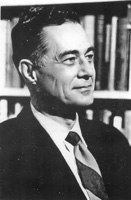|
Ego and Anxiety
The last member of man’s inner spiritual trinity to make its appearance was almost certainly the ego, or conscious individual self. The ego differs from the unconscious id in its keen, almost painful, awareness of social reality and from the group-oriented superego in its isolative, often antagonistic, relation toward other psychic entities—toward the superego and the id attached to itself no less than toward the egos of other individuals.

Roger W. Wescott
Dating the genesis of the ego is a hazardous undertaking, but I am inclined to correlate its development with the appearance of language, religion, and kinship systems. This would mean that the earliest hominid species to possess an ego was the Neanderthal; the earliest culture to embody it, the Mousterian; and the earliest era to behold it, the Middle Paleolithic. Chronometrically, it would mean that the ego is about 100,000 years old—antique in comparison with civilization but newborn in comparison with conscience. (The probability that ego followed conscience in hominian phylogeny is increased by the fact that it seems to do so in the psychic ontogeny of the child.)
As the specific and characteristic emotion of the conscience is guilt, so the specific and characteristic emotion of the ego is anxiety. Most students of personality distinguish anxiety from fear in terms of the palpability of its object, defining fear as an animal’s realistic apprehension of a concrete threat to its welfare and anxiety as its vague apprehension of an abstract threat to something connected with, but not actually constituting, itself. In those terms, then, the discipline termed ego psychology by Anna Freud and her coworkers becomes, not just tangentially but characteristically and primarily, the study of anxiety.
The “unreal” threat of which the ego is most apprehensive is, of course, death, or the cessation of its being. Although all higher animals fear and avoid injury, man appears to be the only animal who fears death even when it is unaccompanied by injury. And the earliest expression of man’s anxiety over nonexistence is the Mousterian funerary cult of Neanderthal Man, with its evident attempt to arrest and ritually reverse the processes of devitalization and decay.
While pre-Neanderthalian men must have undergone conflict between superego and id, there is no evidence that they were aware of it. Neanderthal Man, however, seems to have been conscious of the clash between self and other. It looks as though he strove manfully (how else?) to resolve this conflict by building propitiatory shrines of the skulls of the animals he killed—by treating with gentle reverence what he had previously handled with rapacious disregard.
Neanderthalian panic in the uncanny face of death is but one facet of a more generalized malaise that Austrian psychoanalyst Otto Rank called “separation anxiety.” This anxiety, which he attributed to the traumatic experience of birth (for every infant, he maintained, an “Expulsion from the Garden”), he saw reactivated in every life crisis from weaning through marriage to retirement from active social involvement.
“States of Consciousness” by Roger W. Wescott is an extract from The Highest State of Consciousness edited by John W. White, published by White Crow Books and available from Amazon and other bookstores.
Paperback Kindle
www.whitecrowbooks.com/the highest state of consciousness
|